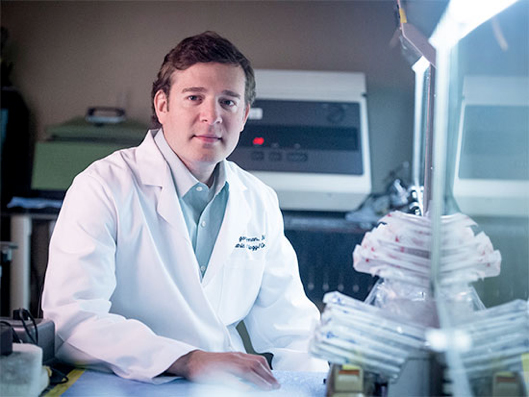Staff Writer, TMN Jul 04, 2018 6 years, 9 months, 2 weeks, 3 days, 10 hours, 54 minutes ago
A viral immunotherapy using a herpes virus to treat brain tumors has been shown to be safe and well-tolerated in a pediatric study from the
University of Alabama at Birmingham. The findings, presented today at the International Symposium on Pediatric Neuro-Oncology in Denver, also showed preliminary evidence of effectiveness in killing malignant tumor cells.
The virus, known as G207, is derived from the herpes virus responsible for cold sores. The virus is genetically altered so that it infects only tumor cells. When infused into a malignant brain tumor, the virus enters the tumor cells and replicates. This kills the cell and releases the virus’s progeny to hunt out other tumor cells. Additionally, the virus induces a strong immune response by the body’s immune system, which can attack the tumor.
Six pediatric subjects have been treated with G207 in the current trial. No dose-limiting toxicities or serious side effects occurred. Five of the six patients had evidence of tumor killing by the virus, including a patient who is over 18 months out with an ongoing response to the therapy without any other treatment.
Gregory Friedman, M.D.
“Our findings indicate that G207 is safe and tolerable in children with progressive malignant brain tumors,” said Gregory Friedman, M.D., primary investigator of the study and an associate professor in the UAB Division of
Pediatric Hematology-Oncology in the
Department of Pediatrics, and Children’s of Alabama and an associate scientist in the UAB Comprehensive Cancer Center.
“Preliminary evidence of efficacy is very promising to date. The next phase of the study will test the safety of G207 combined with a single low dose of radiation, which is being used to enhance virus replication and the immune response against the tumor, within 24 hours of virus inoculation.”
Brain tumors are the most common solid tumor in children, and aggressive types like glioblastoma have an extremely low survival rate: as low as 10 percent five years after diagnosis. Even tumors successfully treated by surgery, radiation and/or chemotherapy have a high rate of recurrence and eventual death.
The use of genetically-engineered oncolytic viruses, those that selectively kill cancer cells as a treatment for brain tumors and other cancers, is the product of more than 20 years of research at UAB by James Markert, M.D., MPH, chair of UAB’s
Department of Neurosurgery and senior scientist in the UAB Comprehensive Cancer Center. The concept was described in the literature in 2001 by Markert and his colleagues. A second-generation virus, called M032, has been developed by Markert and collaborators Yancey Gillespie, Ph.D., professor of neurosurgery, and Richard Whitley, M.D., distinguished professor of pediatric infectious disease, and is in clinical trials at UAB in adults with glioblastoma, the most deadly of primary brain tumors.
Friedman says the ability of the virus to
">kill a cancer cell is valuable, but the real benefit comes from its effect on the immune system. Cancer cells are very good at avoiding detection by the immune system’s killer T cells, meaning that the body does not recognize or mount a vigorous immune response to brain tumors. G207 appears to stimulate the immune system, provoking a robust and continued immune response in some patients.
M032 takes that a step further by introducing a cytokine called Interleukin-12, which acts on nearby lymphocytes and natural killer cells to induce an even stronger antitumor immune response. It also inhibits angiogenesis — the creation of new blood vessels — thereby shutting off the blood supply to tumor cells, denying oxygen and essential nutrients.
“High-grade glioma is a devastating diagnosis,” Friedman said. “We have made very little progress in developing effective therapies over the past 10-15 years. Viral immunotherapy shows great promise at treating all types of malignant brain tumors, although this approach needs to be studied further. But, I think we are on the cusp of a major development.”
Funding for the clinical trial is being provided by the United States Food and Drug Administration, and funding to develop this therapy has been provided by the NIH/NCI.
